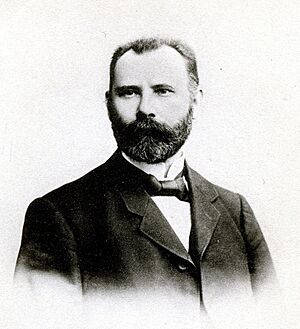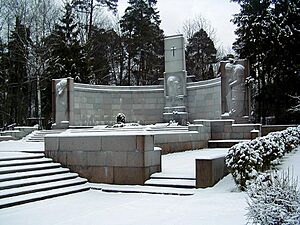Jānis Čakste facts for kids
Quick facts for kids
Jānis Kristaps Čakste
|
|
|---|---|
 |
|
| 1st President of Latvia | |
| In office 17 December 1918 – 14 March 1927 Acting: 17 December 1918 – 14 November 1922 |
|
| Prime Minister | Kārlis Ulmanis Zigfrīds Anna Meierovics Jānis Pauļuks Zigfrīds Anna Meierovics Voldemārs Zāmuēls Hugo Celmiņš Kārlis Ulmanis Arturs Alberings Marģers Skujenieks |
| Succeeded by | Pauls Kalniņš (Acting) |
| Personal details | |
| Born | 14 September 1859 Sesava Parish, Courland Governorate, Russian Empire Now (Jelgava Municipality, Latvia) |
| Died | 14 March 1927 (aged 67) Riga, Latvia |
| Political party | Kadets (1906) Latvian Farmers' Union (1917–1919) Democratic Centre (1922–1927) |
Jānis Kristaps Čakste (born September 14, 1859 – died March 14, 1927) was an important Latvian politician and lawyer. He was the first leader of an independent Latvia. He served as the Chairman of the People's Council from 1918 to 1920. Then he was the Speaker of the Constitutional Assembly from 1920 to 1922. Finally, he became the first President of Latvia from 1922 until his death in 1927.
Contents
Early Life and Education
Jānis Čakste was born in a small village called Lielsesava, which is now part of Jelgava district. His father was a farmer. Jānis went to St Anne's Primary School first. After that, he attended the Academia Petrina in Jelgava.
While at school, he joined student groups that supported new ideas for Latvian culture and identity. In 1882, he finished school and went to Moscow University to study law. In Moscow, Čakste helped start a Latvian Student Society in 1883. He was very active in the Latvian community there, working with other important figures like Krišjānis Valdemārs. Čakste finished his law degree in 1886 and returned to Jelgava.
Career and Start in Politics
After university, Čakste worked in the legal department of the Courland Governorate. From 1888, he started working as a lawyer in Jelgava. In 1889, he became the editor of a newspaper called "Tēvija." This newspaper became one of the most popular Latvian-language newspapers in the Courland region.
In 1895, he helped organize the 4th All-Latvian Song Festival in Jelgava. He even used his own money to help pay for the event. During the Russian Revolution of 1905, Čakste worked on a plan for Latvia to have its own self-government within the Russian Empire.
In 1906, he was chosen to be a member of the First State Duma of the Russian Empire. This was like a parliament in Russia. He joined a liberal political group called the Constitutional Democratic Party. When the Russian ruler (the czar) closed down the Duma, Čakste and 165 other members signed a document called the Vyborg Manifesto. This document asked people to peacefully resist the czar's government. Because he signed it, Čakste was arrested and spent three months in prison.
In 1915, Čakste moved to Tartu. There, he helped create the Central Committee for Latvian Refugee Affairs and became its leader in 1917. He also organized a special event to honor Major General Aleksey Potapov, who defended Jelgava. Potapov later supported the creation of the Latvian Rifles, a special military unit.
In 1917, Čakste planned a trip to the United States to talk about Latvian independence. But his trip was cut short in Stockholm when he heard about the Russian Revolution. In Stockholm, he wrote a pamphlet where he stated that "the Latvian nation wants to... achieve... its freedom... to lead in Latvia its own national, cultural, and economic development." This showed his strong belief in an independent Latvia.
In late 1917, Čakste worked for the Provisional Latvian National Council. He wrote letters to other countries, protesting against Germany's occupation of Baltic lands. On November 17, 1918, Čakste was chosen as the chairman of the Latvian Tautas Padome (People's Council). This council was meant to be the government of the new Latvian state. He wasn't there for the official declaration of independence the next day, so the vice-chairman, Gustavs Zemgals, announced it.
In 1919, Čakste went to the Paris Peace Conference. He met with foreign diplomats and even tried to ask for money from Germany to help rebuild Latvia. However, the main Allied countries did not support this request. On July 13, 1919, he returned to Latvia and started his duties as the Chairman of the Tautas Padome. While leading the country, Čakste also taught law at the new University of Latvia. He became a full professor in November 1919 and later received an honorary law degree in 1924.
First President of Independent Latvia

After the first free elections for the Constitutional Assembly of Latvia, Čakste was chosen as its Speaker on May 1, 1920. This meant he was again the temporary head of the Latvian state. The famous poet and politician Rainis was his main opponent in these elections.
Two years later, on November 7, 1922, Čakste was elected as the first President of the Republic of Latvia. He was the only candidate, and 92 members of the Saeima (Latvia's parliament) voted for him, with only 6 against. This was the most votes any presidential candidate has ever received in Latvia.
As President, Čakste's job was mostly ceremonial, meaning he represented the country. However, he still paid close attention to how Latvia was seen by other countries. During his time as president, he approved 402 laws. He also sent three laws back to the Saeima for them to review again. He pardoned 549 people. In 1926, he pardoned a writer named Andrievs Niedra, who had been jailed. Čakste insisted that Niedra leave the country after being pardoned.
For the 1925 presidential elections, Čakste was nominated by his party, the Democratic Centre. Rainis was nominated by the Social Democrats, and Kārlis Ulmanis by the Latvian Farmers' Union. In the first round of voting, Čakste came in third. But when the Social Democrats decided to withdraw Rainis's name, Čakste won the election with 60 votes.
Jānis Čakste passed away in Riga on March 14, 1927. This was before his second three-year term as president ended. He was buried at the Forest Cemetery in Riga. He is the only President of Latvia to have died while still in office.
Family Life
Jānis Čakste was married to Justīne Čakste, and they had nine children. One of his sons, Visvaldis Čakste, was a soldier who died in 1915 while defending Jelgava. Another son, Konstantīns Čakste (1901–1945), was also a lawyer. He became a leader of the Latvian resistance movement during World War II. He was the chairman of the Latvian Central Council, which was an underground Latvian government formed in 1943. Konstantīns Čakste was arrested by the Gestapo (German secret police) and died in February 1945 during a forced march from a concentration camp.
See also
 In Spanish: Jānis Čakste para niños
In Spanish: Jānis Čakste para niños



